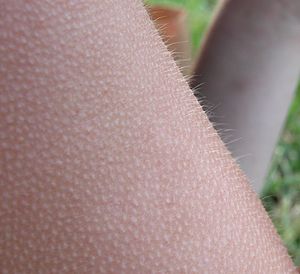Piloerection
| Goose bumps | |
|---|---|
 |
|
| Goose bumps on a human arm | |
| Classification and external resources | |
| Specialty | Dermatology |
| DiseasesDB | 24683 |
Goose bumps, goose pimples or goose flesh are the bumps on a person's skin at the base of body hairs which may involuntarily develop when a person is cold or experiences strong emotions such as fear, euphoria or sexual arousal. The medical term for the effect is cutis anserina or horripilation.
The formation of goose bumps in humans under stress is considered by some to be a vestigial reflex; some believe its function in human ancestors was to raise the body's hair, making the ancestor appear larger to scare off predators. The reflex of producing goose bumps is known as piloerection or the pilomotor reflex. It occurs in many mammals besides humans; a prominent example is porcupines, which raise their quills when threatened, or sea otters when they encounter sharks or other predators.
The phrase "goose bumps" derives from the phenomenon's association with goose skin. Goose feathers grow from stores in the epidermis which resemble human hair follicles. When a goose's feathers are plucked, its skin has protrusions where the feathers were, and these bumps are what the human phenomenon resembles.
It is not clear why the particular fowl, goose, was chosen in English, as most other birds share this same anatomical feature. Some authors have applied "goosebumps" to the symptoms of sexually-transmitted diseases. "Bitten by a Winchester goose" was a common euphemism for having contracted syphilis in the 16th century. "Winchester geese" was the nickname for the prostitutes of South London, licensed by the Bishop of Winchester in the area around his London palace.
This etymology does not explain why many other languages use the same bird as in English. "Goose skin" is used in German (Gänsehaut), Swedish (gåshud), Danish and Norwegian (gåsehud), Icelandic (gæsahúð), Greek (χήνειο δέρμα), Italian (pelle d'oca), Russian (гусиная кожа), Ukrainian (гусяча шкіра), Polish (gęsia skórka), Czech (husí kůže), Slovak (husia koža), Latvian (zosāda) and Hungarian (libabőr).
...
Wikipedia
